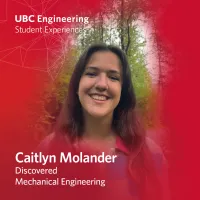
Have you ever wondered how engineers come up with their ideas?
Whether they are developing new biomaterials, earthquake-resistant buildings, AI-enabled techniques to find critical mineral deposits or an electrical grid that’s more resilient to hacking, engineers use design thinking to develop solutions that make people’s lives better.
This design thinking process is an engineer’s superpower.
It’s a tried and tested method that engineers learn in university and then use throughout their professional careers and even in their personal lives when making decisions!
Learning to think like an engineer
You’ll be introduced to the design cycle in your first engineering classes. It will soon become second nature!
In your first year, you’ll get lots of practice with the design cycle any time you need to come up with a solution to an open-ended problem – be that designing and building an autonomous claw or creating a water filtration system for a remote community.
It’s a powerful tool that will help you learn how to innovate and solve problems – and could even change the way you approach decisions outside of class. “My first APSC 100 class was one of the few times I’ve been genuinely surprised by what I’m learning,” said student Myklos Sunario. “Even though I knew that engineering would teach me to solve problems, I was surprised by the extent to which the instructors taught us how to use the design cycle process to make decisions.“

The design cycle in your career
The design cycle is something you’ll use throughout your career as an engineer. Emma Gray is an Engineering Physics grad and Product Manager on Microsoft’s Education Product team where she develops apps for students and teachers that empower learning. She describes the design cycle as the “bedrock of engineering design” and says it’s something she uses every day.
“I work with our design, engineering and research teams (and other experts) to define the problem space, the opportunity within it, and what we should build in response,” she says. “I work iteratively with our technical teams and designers, while checking back with our customers, to make sure that what we’re building truly addresses the problem at hand. It’s the whole APSC 100 engineering design process in action!”
Thinking like an engineer
Learning to think like an engineer will benefit you in areas that extend beyond engineering—from how you tackle technical and non-technical challenges in your job to navigating the many decisions you make throughout your life.
As Pavni Agarwal, an Electrical Engineering grad from 2022 says, “The engineering mindset, with its focus on asking why, reasoning things through, thinking logically and weighing the pros and cons of alternatives, is very valuable. It’s changed me—even in terms of how I make decisions in my personal life!”
Learning how to use the design cycle is just one reason that engineering can be considered one of the most versatile of undergraduate degrees.











